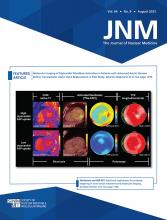REPLY: We would like to thank the author for his interest in our work and for this opportunity to address his queries. The author raises several concerns about our large retrospective study.
We had described a limitation of our methodology that involved reviewing the clinical reports for reported radiopharmaceutical extravasation (RPE) instead of reviewing the scintigraphy images (1). Reviewing the scintigraphy images of around 32,000 studies would surely have been a more accurate but certainly a much less feasible exercise in a finite period. Further, the primary objective of this study was not to detect the rate of RPE of any magnitude but to evaluate the clinical adverse events, if any, associated with the RPE events. We agree that although the actual RPE rate (of any extent) might likely be higher than the clinically reported RPE rates, it is also expected that major RPEs are the most likely to be documented in the report, compared with minimal RPEs. Our results showing no long-term adverse events in patients with reported RPE (likely to represent major RPEs) therefore validate our conclusion. In the absence of clinical adverse events with the documented RPEs, it is highly implausible that the undocumented RPEs (likely of minor extent) would lead to a significant number of clinical adverse events that could change our estimates. Despite the perceived and existent limitations with the health-care systems, clinical follow-up was available for over 80% patients, with the studies performed over approximately 12 y. In addition, comprehensive review of the clinical charts of these patients (including clinical encounters from our medical center and other centers) ensured that we would very likely detect symptoms or signs at the local RPE site, irrespective of whether they were attributed to the RPE event. Our conclusion that clinical adverse events are rare with reported RPEs is therefore firmly supported by our research methodology and the results. We agree that it might be of interest to review all of the approximately 32,000 scintigraphy images directly, and we suggest that an international experience would provide a greater breadth of understanding.
We have endorsed and advocate for improving quantification in nuclear medicine studies. Accurate delivery of radiopharmaceutical activity is important for obtaining reproducible and precise estimates of quantitative parameters such as SUV (2,3). We also acknowledged the potential impact of extravasations on quantification and clinical interpretation of studies in our article. However, quantitative evaluation is not routinely performed and is not required for clinical interpretation of planar bone scintigraphy studies, the study population we assessed. Planar bone scintigraphy studies are generally interpreted with qualitative assessment, hence the rationale for incorporating the requirement of a repeat scan as a surrogate metric for scan quality. The focus of the current study, as mentioned earlier, was on adverse clinical events at the injection site rather than the impact on quantification, which can be addressed in future investigations. Additionally, whereas delivery of the entire radiopharmaceutical activity into the appropriate compartment is surely desired, labeling quantitative results as invalid with less than 100% activity delivery is certainly an overstatement (e.g., a 0.1% extravasation would not meaningfully change quantitation).
Lastly, the consideration of extravasations of therapeutic radiopharmaceuticals is a valid concern for future research. Although this was not an objective of the current study, the need to exercise caution while administering therapeutic radiopharmaceuticals is well recognized in view of their high-energy emissions. However, the author cites a case report attributing extravasation of 223Ra to the development of cutaneous squamous cell carcinoma a few months later (4). All the methodologic limitations of a descriptive single-case report set aside, this report has several additional complexities that make the conclusion of local-radiation–induced carcinogenesis debatable. We would like to highlight some of the major concerns here. The development of a radiation-induced solid tumor at 4 mo after radiation exposure is highly unusual. Several prior studies have reported that solid tumors typically occur 10–15 y after exposure to high-dose ionizing radiation (5–7). It is thus improbable that the extravasation of 223Ra led to exceptionally rapid mutagenesis in the absence of any local tissue damage, with the latter widely recognized as an acute effect of ionizing radiation (8). The likely explanation for these discrepancies in the case report, as well as the absence of other literature documenting similar results, is the possibility of confusing correlation with causation. A brief review of the Bradford Hill criteria for causation clearly shows that the report describes an unfortunate possible correlation and not necessarily causation (9). A very interesting read that emphatically represents this issue is the correlation of annual chocolate consumption with the number of Nobel laureates produced (10). We, however, share the concern that RPE with radiopharmaceutical therapies must be avoided. The author also raises the issue of RPE with antibodies. Although any RPE should certainly be avoided, the clearance of radiolabeled antibodies (whole antibodies and fragments) from the interstitial compartment is relatively rapid (11).
In conclusion, whereas we appreciate the queries raised by the author and his interest in our study, we firmly stand by the findings of our study and believe that our concluding remarks are data-driven and well supported by an appropriate research methodology. We also recognize the potential of future studies with larger patient populations to assess for potential clinical risks of RPE. The sample size of these studies would likely need to be large because the risk of clinical adverse events after radiopharmaceutical injections for diagnostic bone scans appears to be vanishingly low.
Ashwin Singh Parihar, Lisa Raymond-Schmidt, John P. Crandall, Farrokh Dehdashti, Richard L. Wahl*
*Washington University School of Medicine, St. Louis, Missouri
E-mail: rwahl{at}wustl.edu
Footnotes
Published online Jun. 29, 2023.
- © 2023 by the Society of Nuclear Medicine and Molecular Imaging.
REFERENCES
- Received for publication May 22, 2023.
- Revision received May 31, 2023.







